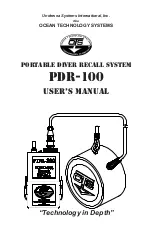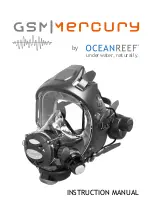
OBS-5+ System
1)
Measures of central tendency, including the mean and median.
2)
Measures of variation or spread in sample values, including the standard
deviation (
σ
) and cumulative percentages, such as X
25
and X
75
(where X is
the depth, SSC, or NTU values).
The mean is the arithmetic average of the values (
∑
x / n), where
∑
x is the
sum of the sample values (x) and n is the number of values (sample size). The
median (X50) is the value that exceeds 50% of the sample values and is the
best measure of central tendency when a sample has outliers. The percentages
X25, X50, X75, etc., exceed 25, 50, and 75% of the sample values.
6.2.9 Sampling Modes and Terms
The following terms concern OBS-5+ sampling schedules.
Interval
: The time in seconds between the start of one sample and the
beginning of the next. The interval must be longer than the duration to allow
for statistical computations and data storage. The computer will prompt you if
you select an interval that is too short.
Duration
: This is the length of time in seconds that the OBS-5+ will measure
its sensors. The duration must always be less than the interval. The minimum
duration is five seconds and the maximum is 2,048 seconds (0.57 hour).
Rate
: Rate is the frequency of sampling for the duration of measurements. All
sensors are sampled at the same rate, typically 2, 5, 10, or 25 times per second
(Hz).
Power
: This indicates the percentage of time over the duration of a sample that
sensors are ON. Higher power levels mean larger samples and better statistics,
but shorter battery life. Lower levels spare the batteries but result in more
random noise in sample statistics (lower signal-to-noise ratios, SNR)
Sample Size
: The number of measurements made by a sensor in each interval;
sample size equals rate times duration.
The main factors to consider when setting up OBS-5+
Cyclic
sampling
schedules include:
•
Sampling interval needed to characterize the processes of interest (for
example, water level fluctuations, flood and transport duration, tidal
conditions, dredge operations, etc.).
•
Maximum sediment concentration.
•
Statistical requirements, such as sample size and sampling rates.
•
Battery capacity.
The goal is to pick a sampling scheme that gets essential information about the
process of interest without taking too many samples or sampling too often.
Inefficient sampling produces excessive battery consumption and a data
avalanche with unnecessary processing. Sampling schedules are set with the
Interval
,
Duration
, and
Rate
parameters.
Interval
sets how often data are
14
Содержание OBS-5+
Страница 2: ......
Страница 8: ...Table of Contents iv ...
Страница 50: ...Appendix A Turbidity Standards A 4 ...
Страница 51: ......
















































